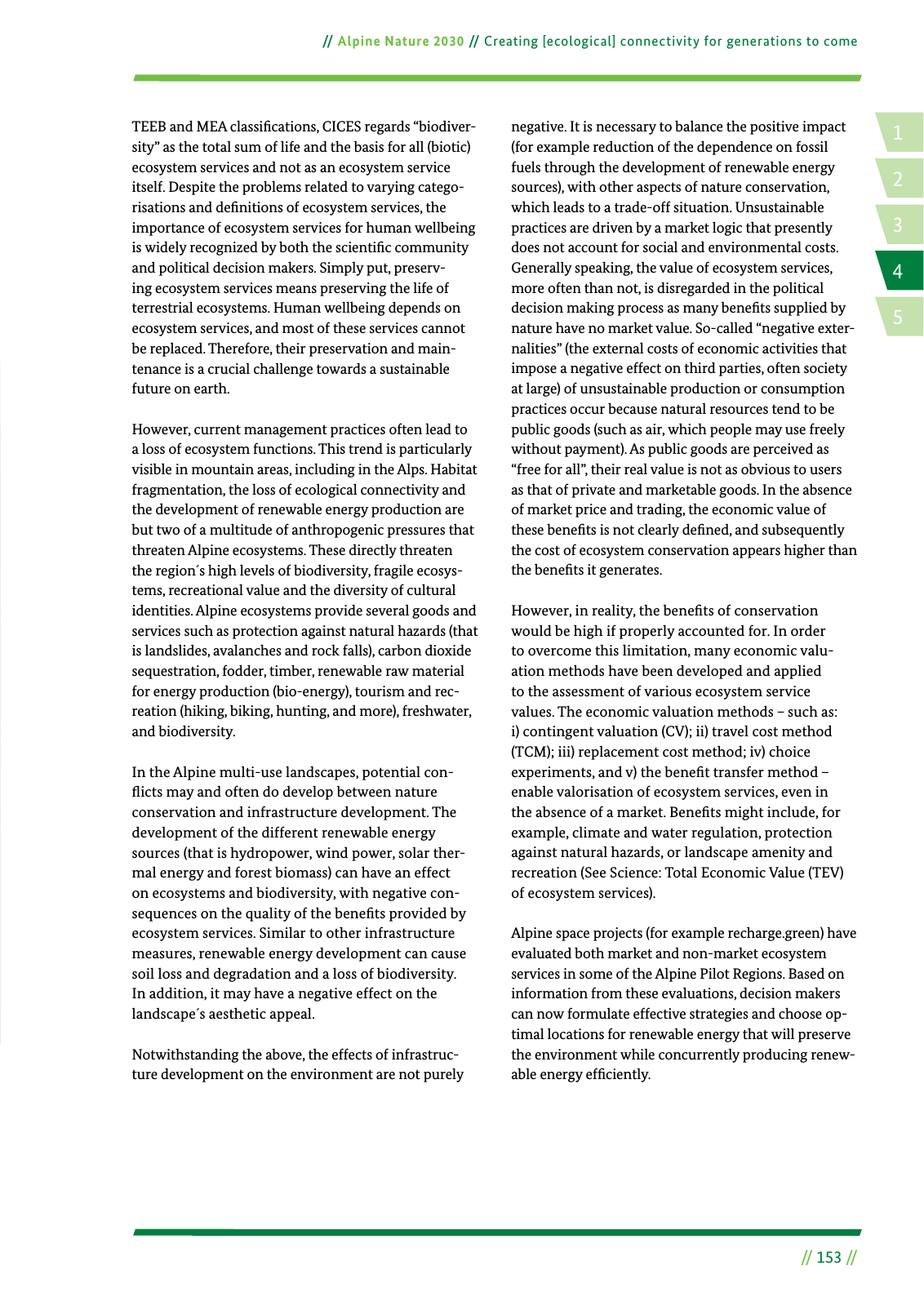14 2 5 3 Alpine Nature 2030 Creating ecological connectivity for generations to come 153 TEEB and MEA classi cations CICES regards biodiver sity as the total sum of life and the basis for all biotic ecosystem services and not as an ecosystem service itself Despite the problems related to varying catego risations and de nitions of ecosystem services the importance of ecosystem services for human wellbeing is widely recognized by both the scienti c community and political decision makers Simply put preserv ing ecosystem services means preserving the life of terrestrial ecosystems Human wellbeing depends on ecosystem services and most of these services cannot be replaced Therefore their preservation and main tenance is a crucial challenge towards a sustainable future on earth However current management practices often lead to a loss of ecosystem functions This trend is particularly visible in mountain areas including in the Alps Habitat fragmentation the loss of ecological connectivity and the development of renewable energy production are but two of a multitude of anthropogenic pressures that threaten Alpine ecosystems These directly threaten the region s high levels of biodiversity fragile ecosys tems recreational value and the diversity of cultural identities Alpine ecosystems provide several goods and services such as protection against natural hazards that is landslides avalanches and rock falls carbon dioxide sequestration fodder timber renewable raw material for energy production bio energy tourism and rec reation hiking biking hunting and more freshwater and biodiversity In the Alpine multi use landscapes potential con icts may and often do develop between nature conservation and infrastructure development The development of the different renewable energy sources that is hydropower wind power solar ther mal energy and forest biomass can have an effect on ecosystems and biodiversity with negative con sequences on the quality of the bene ts provided by ecosystem services Similar to other infrastructure measures renewable energy development can cause soil loss and degradation and a loss of biodiversity In addition it may have a negative effect on the landscape s aesthetic appeal Notwithstanding the above the effects of infrastruc ture development on the environment are not purely negative It is necessary to balance the positive impact for example reduction of the dependence on fossil fuels through the development of renewable energy sources with other aspects of nature conservation which leads to a trade off situation Unsustainable practices are driven by a market logic that presently does not account for social and environmental costs Generally speaking the value of ecosystem services more often than not is disregarded in the political decision making process as many bene ts supplied by nature have no market value So called negative exter nalities the external costs of economic activities that impose a negative effect on third parties often society at large of unsustainable production or consumption practices occur because natural resources tend to be public goods such as air which people may use freely without payment As public goods are perceived as free for all their real value is not as obvious to users as that of private and marketable goods In the absence of market price and trading the economic value of these bene ts is not clearly de ned and subsequently the cost of ecosystem conservation appears higher than the bene ts it generates However in reality the bene ts of conservation would be high if properly accounted for In order to overcome this limitation many economic valu ation methods have been developed and applied to the assessment of various ecosystem service values The economic valuation methods such as i contingent valuation CV ii travel cost method TCM iii replacement cost method iv choice experiments and v the bene t transfer method enable valorisation of ecosystem services even in the absence of a market Bene ts might include for example climate and water regulation protection against natural hazards or landscape amenity and recreation See Science Total Economic Value TEV of ecosystem services Alpine space projects for example recharge green have evaluated both market and non market ecosystem services in some of the Alpine Pilot Regions Based on information from these evaluations decision makers can now formulate effective strategies and choose op timal locations for renewable energy that will preserve the environment while concurrently producing renew able energy ef ciently

Hinweis: Dies ist eine maschinenlesbare No-Flash Ansicht.
Klicken Sie hier um zur Online-Version zu gelangen.
Klicken Sie hier um zur Online-Version zu gelangen.